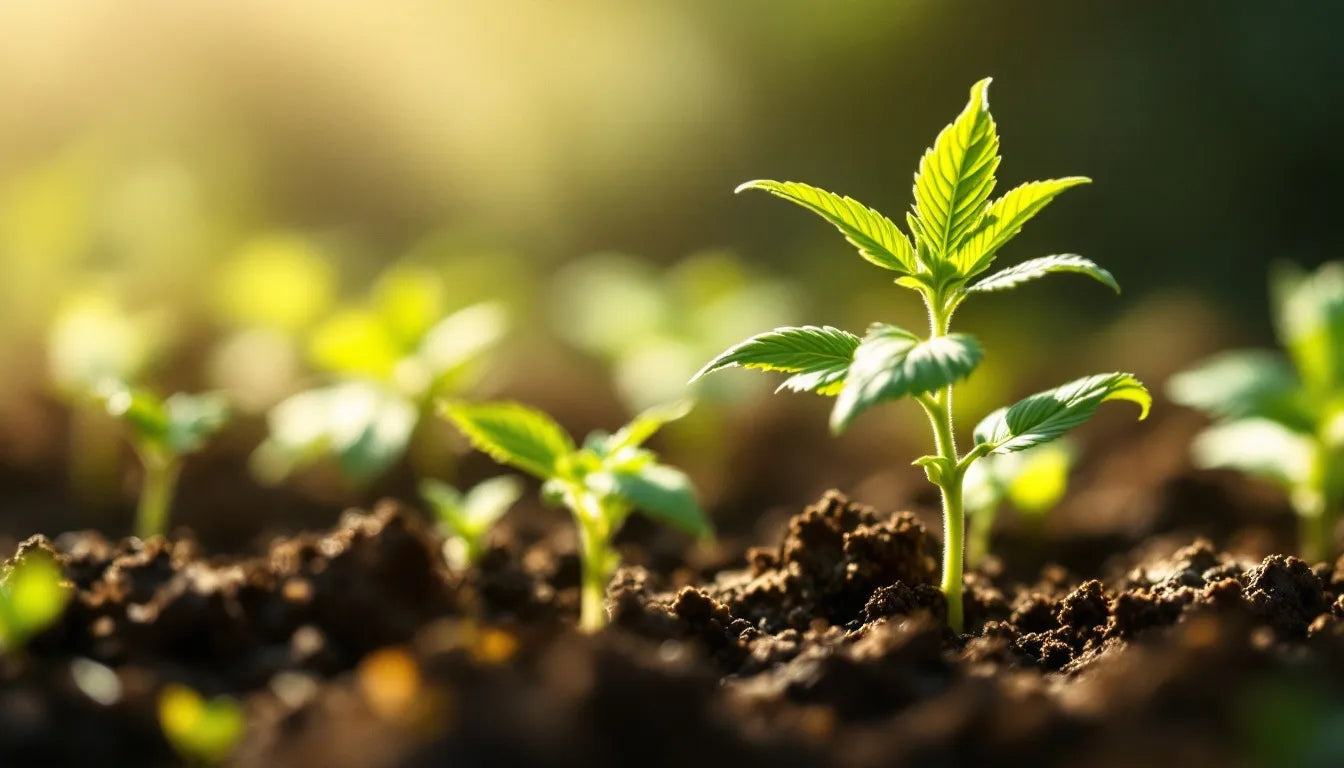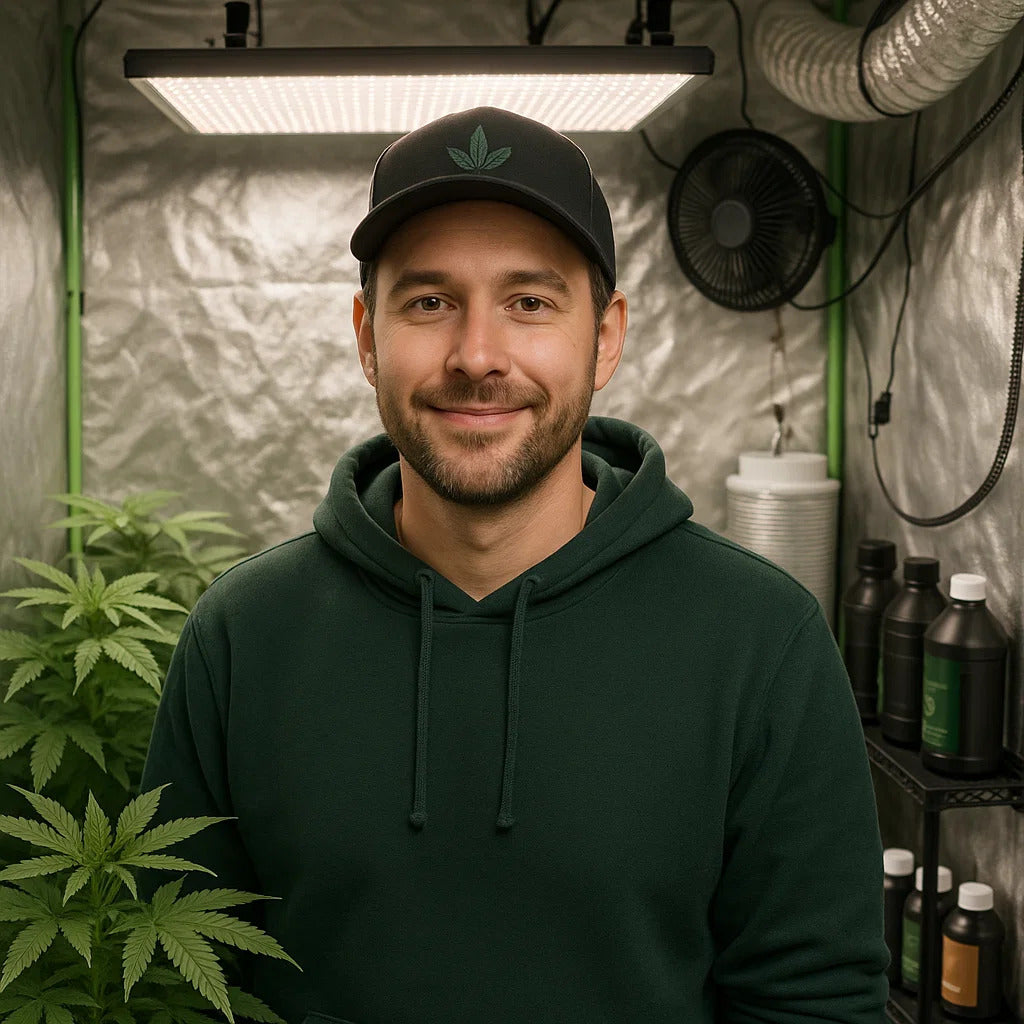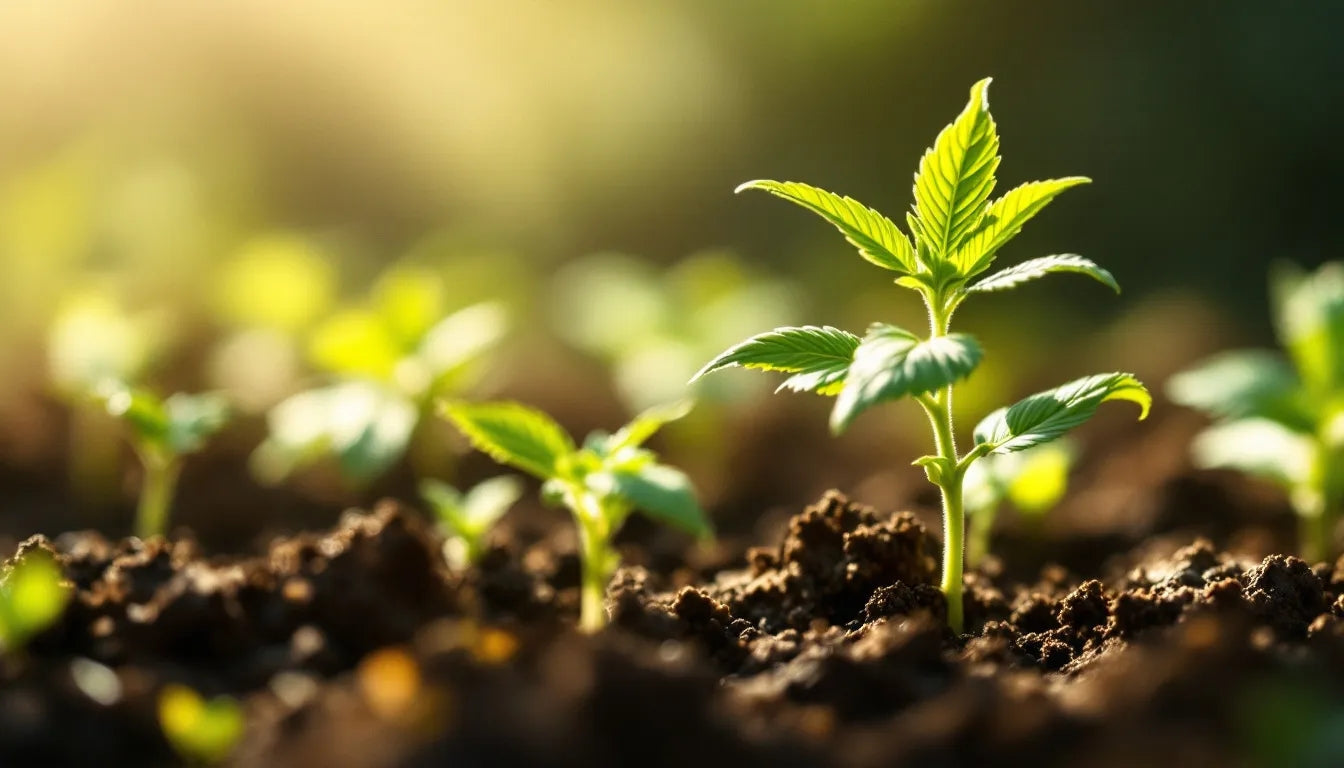Article: How to Grow a Seed of Weed: Your Complete Germination & Early Growth Guide

How to Grow a Seed of Weed: Your Complete Germination & Early Growth Guide
Growing cannabis from seed is one of the most rewarding experiences for any cultivator, but it all starts with successfully germinating those tiny seeds and nurturing them through the critical early stages. While the process might seem intimidating for beginners, germinating cannabis seeds is surprisingly straightforward when you understand the fundamentals and use proven techniques.
Setting up your first grow with a quality grow tent kit provides the perfect controlled environment for germinating seeds and raising healthy seedlings from day one.
Understanding Cannabis Seeds: The Foundation of Your Grow
Before you can grow a seed, you need to understand what makes cannabis seeds viable and how to select the best genetics for your goals.

What Makes a Good Cannabis Seed?
Visual Indicators of Healthy Seeds:
- Dark Color: Mature seeds are brown, tan, or dark gray
- Hard Shell: Firm to gentle pressure, not soft or crumbly
- Waxy Coating: Slight sheen or tiger-stripe patterns
- Proper Size: Plump and rounded, not flat or shriveled
Seeds to Avoid:
- Pale green or white (immature)
- Cracked or damaged shells
- Soft or squishy texture
- Extremely small or misshapen
Storage Matters: Cannabis seeds remain inactive until they are exposed to water and light. They are relatively strong and survive well in dark, cool places such as refrigerators, but temperatures below freezing can damage or kill them.
Types of Cannabis Seeds
Feminized Seeds:
- Produce 99.9% female plants
- Best for beginners - no need to identify and remove males
- Only females produce consumable flowers
- Most popular choice for home growers
Regular Seeds:
- Natural 50/50 male-female ratio
- Males must be removed before pollinating females
- Used by breeders for creating new genetics
- More challenging for beginners
Autoflowering Seeds:
- Automatically flower after 3-5 weeks regardless of light schedule
- Complete lifecycle in 8-12 weeks
- Typically stay 1.5-3.5 feet tall
- Excellent for first-time growers
Recommendation: Start your first grow with feminized autoflower seeds for the highest success rate and simplest growing experience.
The Paper Towel Germination Method (Most Reliable)
The paper towel method is trusted by growers worldwide because it provides visibility, control, and consistently high germination rates when done properly.
Why the Paper Towel Method Works
Visibility: You can see exactly when the seed cracks and the taproot emerges, eliminating guesswork.
Control: Easy to maintain proper moisture without overwatering or drying out.
High Success Rate: Most cannabis seeds will germinate in 1-5 days using the paper towel method when conditions are right.
Cost-Effective: Uses materials you likely already have at home.
Materials Needed
- Cannabis seeds (quality genetics are essential)
- Paper towels (cheap ones work best - roots don't grow into them)
- Two dinner plates (to create a contained environment)
- Distilled or filtered water (avoid tap water with high chlorine)
- Plastic bag or container (optional, for humidity control)
- Seedling heat mat (optional but recommended)
Temperature Control: The ideal temperature for germination is between 68-72°F (20-22°C). A seedling heating mat maintains consistent warmth.
Step-by-Step Paper Towel Germination
Follow these precise steps for the highest germination success rate.

Detailed Germination Process
Step 1: Prepare Your Workspace
- Clean your work area thoroughly
- Wash your hands with soap and water
- Gather all materials before starting
Step 2: Moisten the Paper Towels
- Take 4 sheets of paper towels
- Dampen them with filtered water (moist, not dripping)
- They should be thoroughly wet but shouldn't have excess water dripping
- Wring out any excess water
Step 3: Layer and Place Seeds
- Lay 2 damp paper towels flat on your first plate
- Place seeds on the towels, spacing them at least 1 inch apart
- This spacing prevents roots from tangling and makes transplanting easier
- If germinating multiple strains, label them now
Step 4: Cover the Seeds
- Place the remaining 2 moist paper towels over the seeds
- Gently press down to ensure good contact with seeds
- Make sure seeds are completely covered
Step 5: Create Dark, Humid Environment
- Place second plate upside down over the first (like a dome)
- Or seal in a plastic bag with a few air holes
- The cover should lock in moisture while allowing some airflow
Step 6: Maintain Proper Conditions
- Place setup in a warm, dark location (cupboard, closet, or on top of fridge)
- Use seedling heat mat underneath if available
- Ideal temperature: 70-85°F (20-30°C)
Step 7: Monitor Daily
- Check moisture levels every 24 hours
- If paper towels appear dry, lightly mist with water
- Avoid lifting towels unnecessarily to prevent disturbing seeds
When Seeds Have Germinated
Timeline: Cannabis seeds typically germinate within 24-72 hours, though some may take up to a week.
Signs of Success: You'll see a small white root (taproot) emerging from the seed shell. This delicate root is the foundation of your plant.
Ready to Plant: Once the taproot is 1/4 to 1/2 inch (6-12 mm) long, it's time to transplant carefully.
For more details on the complete growing process, check out our guide on how to grow a weed plant.
Alternative Germination Methods
While the paper towel method is most popular, other techniques work well depending on your preference.
Direct Soil Planting
Process:
- Plant seed 1/4 to 1/2 inch deep in moist soil
- Keep soil consistently moist (not soaked)
- Seedling emerges in 3-7 days
Pros: No transplant shock, mimics natural growth Cons: Can't monitor progress, risk of overwatering
Water Soaking Method
Process:
- Drop seeds into glass of room-temperature water
- Keep in warm, dark place
- Seeds sink when ready (12-24 hours)
- Plant immediately when taproot appears
Pros: Fast hydration, simple process Cons: Risk of drowning seeds if left too long, less visibility
Starter Cubes or Plugs
Process:
- Insert seed into pre-moistened growing cube
- Keep cube moist under humidity dome
- Transplant entire cube when roots appear
Pros: Easy transplanting, minimal handling Cons: Additional cost, can dry out quickly
Recommendation: Beginners should stick with the paper towel method for maximum visibility and control.
Transplanting Germinated Seeds
This critical step requires gentle handling to avoid damaging the delicate taproot.

Preparing Your Growing Medium
Container Choice:
- Start in small containers (2-4 inch pots or solo cups)
- Ensure drainage holes at bottom
- Fill with quality seedling mix or light soil
Growing Medium Options:
- Quality potting soil (easiest for beginners)
- Coco coir mixed with perlite (faster growth)
- Seedling-specific growing medium
Pre-Moistening: Water the growing medium until moist but not soggy before transplanting.
Transplanting Technique
Step 1: Create Planting Hole
- Make a hole 1/2 inch (12 mm) deep
- Slightly wider than the seed
- Use your finger or a pencil
Step 2: Handle Seed Carefully
- The taproot is extremely delicate - treat it gently
- Use clean tweezers to pick up seed by the shell (never touch the white root)
- Alternatively, use very clean fingers
Step 3: Plant Correctly
- Place seed in hole with taproot pointing downward
- This is crucial - the taproot naturally grows down
- Position seed about 1/4 to 1/2 inch below surface
Step 4: Cover Gently
- Lightly cover with growing medium
- Don't pack soil down firmly
- Mist surface lightly with water
Step 5: Create Humidity Dome
- Cover with clear plastic cup or humidity dome
- This maintains moisture while seed establishes
- Remove dome once seedling emerges (2-7 days)
Seedling Care: The First 2-3 Weeks
Once your seed sprouts, it enters the vulnerable seedling stage that requires careful attention.
Optimal Seedling Conditions
Light Requirements:
- Schedule: 18 hours light, 6 hours darkness (18/6)
- Distance: Keep LED lights 24-36 inches away initially
- Intensity: Gentle light - seedlings are sensitive
- Type: Full-spectrum LED or fluorescent grow lights
Temperature & Humidity:
- Temperature: 68-77°F (20-25°C)
- Humidity: 65-70% for optimal growth
- Air Circulation: Gentle breeze from small fan (strengthens stems)
Watering:
- Use spray bottle to mist soil surface
- Keep soil moist, never soaking wet or completely dry
- Overwatering is the #1 killer of seedlings
- Water when top 1/2 inch of soil feels dry
What to Expect During Seedling Stage
Day 1-3: Seed shell breaks through soil surface
Day 3-7: Cotyledon leaves (round embryonic leaves) open and green up
Day 7-14: First set of true serrated cannabis leaves appear
Week 2-3: Multiple sets of leaves develop, stem thickens
Growth Rate: This stage lasts from 1 to 4 weeks and is the period of greatest vulnerability in the life cycle of the plant.
Common Seedling Problems and Solutions
Stretching (Tall, Leggy Growth):
- Cause: Insufficient light
- Solution: Move light closer, increase light intensity
Damping Off (Seedling Falls Over):
- Cause: Fungal infection from overwatering
- Solution: Reduce watering, improve air circulation, start over with clean equipment
Yellow Leaves:
- Cause: Overwatering, poor drainage, or nutrient issues
- Solution: Let soil dry slightly, check drainage holes
Slow Growth:
- Cause: Wrong temperature, poor light, or compacted soil
- Solution: Check environmental conditions, ensure proper temp/humidity
Stunted Growth:
- Cause: Root problems, poor soil, or nutrient deficiency
- Solution: Check roots for rot, use quality soil, add gentle nutrients after week 2-3
When to Transplant Seedlings
Knowing when to move seedlings to larger containers is crucial for continued healthy growth.
Signs Seedlings Are Ready
Root Development:
- Roots visible through drainage holes
- Plant has 2-4 sets of true leaves
- Typically 2-3 weeks after germination
Size Indicators:
- Seedling is 3-4 inches tall
- Stem is sturdy and thick
- Leaves are vibrant green
Transplant Timing: Most growers transplant seedlings to 1-gallon pots after 2-3 weeks, then to final 3-5 gallon containers after another 2-3 weeks.
Transplanting Process
- Water seedling 1-2 hours before transplanting
- Prepare new container with fresh growing medium
- Gently remove seedling from current container
- Place in new container at same depth
- Fill around root ball with soil
- Water gently to settle soil
- Keep in shade for 24 hours to reduce stress
Learn more about container sizes and plant development in our guide on how many weed plants can you grow.
Setting Up the Perfect Germination Environment
Creating optimal conditions dramatically increases germination success rates.
Indoor Germination Setup
Space Requirements:
- Small designated area for germination
- Warm, dark, undisturbed location
- Small grow tent perfect for seedling stage
Temperature Control:
- Seedling heat mat (provides consistent 70-80°F)
- Thermometer to monitor conditions
- Avoid cold drafts or temperature fluctuations
Humidity Management:
- Humidity dome or clear plastic covers
- Spray bottle for misting
- Hygrometer to measure humidity (target 65-70%)
Lighting for Seedlings:
- Gentle fluorescent or LED lights
- 18/6 light schedule once seedlings emerge
- Keep lights 24-36 inches away initially
Complete Growing Setup
Once seedlings are established, you'll need a proper growing environment. A complete grow tent kit includes:
- Grow tent with reflective interior
- Full-spectrum LED lighting
- Ventilation and carbon filter
- Temperature/humidity control
- Growing containers and medium
Investment Benefits: Complete kits eliminate guesswork and ensure all components work together perfectly from seed to harvest.
Frequently Asked Questions About Growing Cannabis Seeds
How long does it take for cannabis seeds to germinate?
Most cannabis seeds germinate within 24-72 hours using the paper towel method, though some may take up to a week. Factors affecting germination speed include seed age, storage conditions, temperature, and moisture levels.
What if my seeds don't germinate?
If seeds haven't sprouted after 7-10 days, they likely won't germinate. Causes include old seeds, improper storage, too cold/hot temperatures, too much/little water, or poor seed genetics. Always buy from reputable seed banks and store properly.
Can you germinate old cannabis seeds?
Yes, but success rates decrease with age. Seeds stored properly (cool, dark, dry) can remain viable for 2-5 years. Pre-soak older seeds for 12-24 hours before using the paper towel method to improve germination rates.
Do cannabis seeds need light to germinate?
No, seeds germinate best in complete darkness. Seeds require water, heat, and air to take root effectively, but light comes later. Once sprouted and planted, provide light immediately when the seedling emerges from soil.
How deep should you plant cannabis seeds?
Plant germinated seeds 1/4 to 1/2 inch (6-12 mm) deep with the taproot pointing downward. If direct planting un-germinated seeds in soil, plant them 1/4 to 1/2 inch deep as well.
What's the best temperature for germinating cannabis seeds?
The ideal temperature range is 70-85°F (20-30°C), with 72-78°F being optimal. Temperatures below 68°F slow germination, while temperatures above 85°F can damage seeds or encourage mold growth.
Maximizing Germination Success Rate
Professional growers use these techniques to achieve 90%+ germination rates.
Pre-Germination Tips
Seed Selection:
- Buy from reputable seed banks
- Choose fresh seeds (check production date)
- Inspect visually for dark color and firm texture
Pre-Soaking (Optional):
- Soak seeds in water for 12-24 hours before paper towel method
- "Wakes up" seeds and softens shell
- Seeds should sink when ready
Scarification (For Difficult Seeds):
- Gently rub seed between fine sandpaper
- Creates micro-abrasions that help water penetration
- Use only on very old or thick-shelled seeds
During Germination
Maintain Consistency:
- Keep temperature stable (avoid fluctuations)
- Check moisture daily
- Don't disturb seeds unnecessarily
Sterile Conditions:
- Use clean equipment and workspace
- Wash hands before handling seeds
- Use filtered or distilled water
Patience:
- Don't give up too early
- Some strains take longer than others
- Wait full 7-10 days before declaring failure
From Seed to Vegetative Growth
Once your seedling is established with several sets of leaves, it transitions to the vegetative stage.
Vegetative Stage Begins
Timing: Usually 2-4 weeks after germination
Characteristics:
- Rapid vertical and horizontal growth
- Multiple leaf sets developing quickly
- Stem thickening and strengthening
- Root system expanding significantly
Care Adjustments:
- Increase light intensity gradually
- Begin feeding with nutrients (1/4 strength)
- Water more frequently as plant size increases
- Maintain 18/6 or 20/4 light schedule
Duration: Vegetative stage lasts 4-8 weeks before flowering, though growers control this timing with photoperiod plants.
For complete information on all growth stages, read our comprehensive guide on cannabis grow stages.
Summary: Successfully Growing Cannabis from Seed
Quick Answer: Growing a cannabis seed involves selecting quality genetics, germinating using the paper towel method (24-72 hours), carefully transplanting when taproot is 1/4-1/2 inch long, and providing optimal seedling care for 2-3 weeks. Success requires maintaining 70-80°F temperature, proper moisture levels, and gentle lighting once sprouted.
Key Takeaways: The paper towel method provides highest germination visibility and success rates. Handle germinated seeds gently by the shell, never touching the delicate taproot. Seedling care requires careful watering (avoid overwatering), gentle lighting, and proper temperature/humidity control during the critical first 2-3 weeks.
Start Growing From Seed Today
Ready to begin your growing journey from seed? Success starts with quality genetics and proper germination techniques, followed by a controlled environment for healthy seedling development.
Explore our complete selection of grow tent kits designed specifically for successfully growing from seed. Each kit provides the optimal environment for germination, seedling care, and full-cycle cultivation.
For beginners just starting with seeds, consider our small grow tents perfect for 1-2 plants and ideal for learning proper techniques.
As your plants grow, enhance your setup with grow tent accessories including humidity domes, seedling heat mats, and gentle lighting systems.
Want to learn advanced growing techniques? Check out our guides on how tall do weed plants grow and indoor growing methods to maximize your results.
Remember: Every successful cannabis plant starts with a properly germinated seed. Master the germination process, provide excellent seedling care, and you'll build a strong foundation for healthy, productive plants. With the right knowledge and equipment, you'll soon enjoy the rewards of growing your own cannabis from seed to harvest.

Lena Myles
I'm a mushroom enthusiast and home cook based in Oregon. I'm passionate about foraging and creating fungi-focused recipes, especially delicious, plant-based dishes using gourmet mushrooms like trumpet, shiitake, and oyster. When I’m not in the kitchen, you’ll usually find me wandering the woods in search of new wild flavors.

